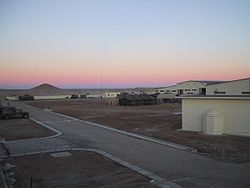Coordinates: 30°29′12″N 064°31′32″E / 30.48667°N 64.52556°E

FOB Rhino, December 2001
Forward operating base (FOB) Rhino, also known as Camp Rhino, was the first US land base established in Afghanistan during Operation Enduring Freedom. It was located in the Registan Desert, 100 nautical miles (190 km) southwest of Kandahar.
History[]
The FOB was captured by what is regarded as the longest helicopter raid in history. The site was observed by US Navy SEALs for four days prior to the Marines from the 15th MEU and Charlie Company BLT 1/1 (Battalion Landing Team) landing to capture it on 25 November 2001.[1] Before its capture, it is believed that the small desert outpost was being built for use as a drug distribution hub.[2] The facility was surrounded by a 10-foot (3 m) wall and four hardened guard towers. Within the facility there were numerous new warehouses, offices, and even a small mosque which was declared off limits to all personnel as a sign of respect. The paint on some of the buildings was barely dry. Sealed roads ran throughout the camp, and it was also bisected by a 3-foot-deep (0.91 m) cement moat.

Infantrymen from the 15th MEU at Camp Rhino on 25 November 2001.
While under the cover of darkness, CH-53E Super Stallions and AH-1W Super Cobra helicopters, from the 15th Marine Expeditionary Unit on board the amphibious assault ship USS Peleliu flew the Marine assault force 372 nmi (689 km) from the North Arabian Sea, through Pakistan, to secure the camp. The CH-53Es utilized aerial refueling from KC-130 tankers, while the AH-1Ws used an existing Forward Arming and Refueling Area (FARP) as they proceeded north.[3] Once the initial insert of forces was complete via the CH-53Es, multiple waves of KC-130 and C-17 aircraft allowed for quick build-up of combat power. At its peak, approximately eight CH-46E from HMM-163, four CH-53E from HMH-465, three UH-1N, and four AH-1W aircraft from HMLA-169 were deployed there. These helicopters made squadron HMM-163(REIN). More UH-1N and AH-1W helicopters joined the mission from the 26th MEU.
Camp Rhino was in use from 26 November 2001 to 1 January 2002. At its peak, the camp contained about 1100 US Marines and sailors, Australian Special Air Service Regiment soldiers, and dozens of embedded reporters.[4] The troops were commanded by Brigadier General James Mattis, USMC. Combat patrols and encounters of the enemy were constant. Camp Rhino also served as a detention facility for the American Taliban John Walker.[5] Life at the spartan Camp Rhino was rough. There were no showers or wash facilities, no messing facilities (only ration packs), every drop of water had to be flown in, and most troops were simply accommodated in a large, open warehouse building. Troops were either sleeping on the cold cement of the warehouse or on the cold dirt outside the camp. The uncertain, tactical nature of the base meant that lights were generally not allowed after dark, and aircraft only operated at night. The base was surrounded by extremely desolate desert terrain resembling the surface of the moon.
Strategic importance[]
Camp Rhino was the US-led coalition's first strategic foothold in Afghanistan and made the ground war in Afghanistan possible. While Rhino was being established, fierce battles between Taliban and Northern Alliance troops were still underway near Kandahar. But then the Taliban, realizing that US forces were now very close and were willing to operate at night, capitulated and retreated north to the mountains of Tora Bora. Supported by the USMC 26th MEU, the coalition forces based at Rhino then moved up to capture the Taliban stronghold of Kandahar International Airport in mid-December 2001, following a three-week period of consolidation at Rhino.[6] Kandahar International Airport then became the main coalition base in southern Afghanistan, while Bagram Air Base was established further to the north near Kabul. The majority of forces who had initially based out of Rhino had re-located to Kandahar by Christmas Day.
See also[]
- Kandahar International Airport
- Military operations of the War in Afghanistan (2001–present)
- Operation Enduring Freedom - Afghanistan: Allies
- Camp Phoenix
References[]
- ↑ Fox News, Navy SEALs Describe 96-Hour Covert Op, 21 December 2001, Retrieved 3 November 2010
- ↑ Australian Defence Force, Afghanistan media briefing, 10 December 2002
- ↑ strategypage.com, Unclassified Documents From Marine Task Force 58’s Operations in Afghanistan - Execution 25 November to 25 December, Retrieved 3 November 2010
- ↑ strategypage.com, ibid
- ↑ CNN, U.S. Taliban fighter held at Marine base in Afghanistan, 8 December 2001, Retrieved 3 November 2010
- ↑ Marine Corps Institute, Afghanistan: An introduction to the country and people, p.34, Retrieved 3 November 2010
External links[]
- On The Scene: Camp Rhino, CBS News, 11 Dec 2001
- Forward Operating Base Rhino, globalsecurity.org
- specialoperations.com
- Registan Desert (Google Maps)
The original article can be found at Camp Rhino and the edit history here.